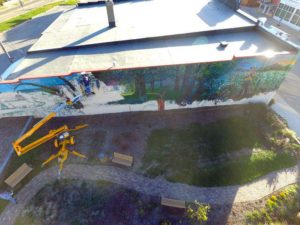Since returning from the National Rural Assembly I’ve been reaching out to small town leaders and advocates with a question: “Why does so little of the federal grant money set aside for creative placemaking flow into Iowa?”
The National Endowment for the Arts set up the Our Town grant program for creative placemaking and began issuing grants in 2011. Since that time, only two Iowa applications have been successful. Of all the money issued by the NEA for this purpose, less than 1 percent has flowed into Iowa communities.
Responses to my question have been as varied as the backgrounds and experiences of the people I’ve asked. Some feel the national application process favors states on the coasts. Others lament a lack of the local partnerships required for such grants. As always for our smaller communities, there are more grant opportunities than time and people to complete them.
Of course, those answers were received from those familiar with the term “creative placemaking.” About half the people I approached were unaware of the process, or held a misunderstanding about it — even when they were engaged in initiatives that could fall under the moniker.

In the small town of Oakland in western Iowa, for instance, a local artist — Zack Jones of Malvern — is busy creating a new mural on the side of the Nishna Heritage Museum to reflect the community’s past and resiliency. The project is partly funded through an Iowa Arts Council grant, and expected to be completed in December. But while the mural may be one of the most discussed improvements, it’s hardly the only one.
Across the street from the museum, a Memory Garden incorporates bricks from the buildings that once stood there. A Main Street Block Party in September brought the community together for live music, classic cars and a free evening meal.
Just down the road in Jones’ Malvern, a grand opening is taking place this weekend. Fine Arts on Fifth, an art gallery and studio, will open and Project Art Church, a combination art gallery, artist studio space and live entertainment venue, will join the celebration. Earlier this year the entities joined forces with businesses across 10 communities to support a Southwest Iowa Art Tour intended to “connect communities through art.”
That’s the key sentiment behind creative placemaking, according to the NEA: “In creative placemaking, partners from public, private, non-profit and community sectors strategically shape the physical and social character of a neighborhood, town, tribe, city or region around arts and cultural activities. Creative placemaking animates public and private spaces, rejuvenates structures and streetscapes, improves local business viability and public safety, and brings diverse people together to celebrate, inspire and be inspired.”
The process requires strategic action by cross-sector partners, a place-based orientation and a core of arts and cultural activities. By design the framing is broad to allow flexibility within individual communities to adopt visions unique to their history and character.
In many ways, Iowa communities are already doing it. What seems to be missing is a broad, shared vision — or the organization necessary to move beyond project-based thinking to an overall philosophy of using arts to connect and inspire the community in ways that aren’t possible without them.
Much of what we are doing in Iowa seems related to a more traditional view of the connection between arts and economic development. That is, we bring artists or art organizations in when we think they are needed to gentrify or civilize a place. Or we think that the arts should be regulated to specific centers or districts.
But creative placemaking requires arts to connect and promote. Arts must be integrated with, and even central to, community and economic development initiatives. It can’t be kept behind barriers or within certain spaces if we intend it to flourish and build upon itself. Creativity spawns creativity, and places have histories and meanings that go beyond the sum of their physical elements.
When Iowans begin to make those connections — when we shift our thinking to understand that spaces have objects and places have identities — we’ll begin to reap not only the grant money, but the economic rewards of placemaking.
This column by Lynda Waddington originally published in The Gazette on November 8, 2015. Photo credit: Nishna Museum
